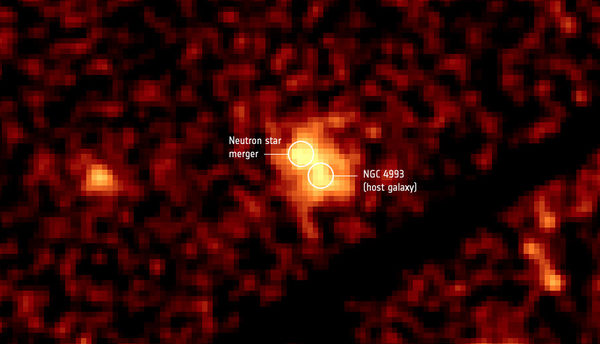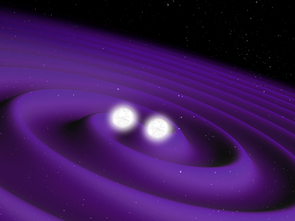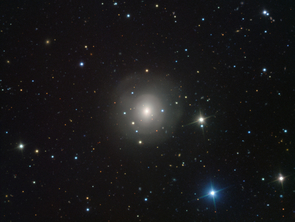Cosmic blast takes rest at last
31 May 2018
Last year, the first detection of gravitational waves linked to a gamma-ray burst triggered a vast follow-up campaign with ground and space telescopes to study the aftermath of the neutron star merger that gave rise to the explosion. ESA's XMM-Newton observations, obtained a few months after the discovery, caught the moment when its X-ray emission stopped increasing, opening new questions about the nature of this peculiar source. |
| XMM-Newton's view of a neutron star merger. Credit: ESA/XMM-Newton; P. D'Avanzo (INAF–Osservatorio Astronomico di Brera) |
Gravitational waves, predicted by Albert Einstein's general theory of relativity in 1918, are ripples in the fabric of spacetime caused by accelerating massive objects like colliding pairs of neutron stars or black holes.
These fluctuations, which remained elusive for a century after the prediction, can now be detected using giant experiments on the ground such as the Laser Interferometer Gravitational-wave Observatory (LIGO) in the United States and Europe's Virgo interferometer.
After a gravitational wave detection, scientists mobilise a large number of ground- and space-based astronomical facilities to look for a possible counterpart of the waves across the electromagnetic spectrum and learn more about their source.
All but one of the six gravitational-wave events that have been observed since 2015 had no evidence of an electromagnetic counterpart, in agreement with the fact that they originated from the merger of black holes – a cosmic phenomenon that is not expected to release any light.
This is why the first detection of gravitational waves jointly with gamma rays, on 17 August 2017, gave rise to a worldwide sensation, launching an observing campaign that involved observatories across the globe and in space to follow the evolution of this never-before-seen phenomenon.
 |
| Colliding neutron stars. Credit: ESA, CC BY-SA 3.0 IGO |
ESA's INTEGRAL and NASA's Fermi gamma-ray satellites had detected the blast only two seconds after its gravitational waves had passed through the LIGO and Virgo detectors, linking the gamma-ray burst to the source of the spacetime ripples, caused by the coalescence of two neutron stars – dense remnants that form at the end of a massive star's life.
Scientists then looked for the afterglow of the explosion created by the neutron star merger, which they expected to observe at longer wavelengths, from X-rays to radio waves. While the optical signal was received about half a day after the original detection, it took no less than nine days for the first observations of this object in X-rays and radio waves.
The delay of the X-ray and radio afterglow contains information about the geometry of the explosion, suggesting that it might have generated two symmetric and collimated jets, neither of which, however, pointed towards Earth.
The X-ray observations were performed with NASA's Chandra X-ray Observatory and other space telescopes. Chandra kept an eye on this source during the following months, recording an ever increasing trend in its X-ray brightness.
Due to observational constraints, XMM-Newton could not observe the aftermath of this cosmic clash for the first four months after its first detection. When it eventually did so, on 29 December 2017, the X-ray brightness seemed to have stopped rising.
 |
| New source in galaxy NGC 4993. Credit: ESO/A.J. Levan, N.R. Tanvir, CC BY 4.0 |
"The XMM-Newton observations had a very good timing," explains Paolo D'Avanzo from INAF – Osservatorio Astronomico di Brera, Italy.
D'Avanzo is the lead author of the paper reporting the results, published this month in Astronomy & Astrophysics.
"By measuring the same value seen by Chandra earlier that month, XMM-Newton provided the first evidence that the source had reached its X-ray peak, and that its incessant brightening had finally come to a halt," he adds. "This was later confirmed by another team of scientists who keep monitoring the source with Chandra."
Scientists expected that the X-ray brightness would reach a peak after a few months, as the material that had been ejected and heated up by the explosion slowly decelerated into the surrounding interstellar medium. The further evolution of the system, however, could still have some surprises in store.
If the explosion did produce two symmetric jets that are not pointing towards Earth, as inferred from the first observations, its X-ray output will decrease rapidly.
But there is another possibility that could explain the data obtained so far: the explosion could have also happened as a spherical 'fireball', without jets, but with a much lower energy. In this case, the X-ray brightness would decrease at a more leisurely pace after the peak.
"We are eager to see how this source will behave over the coming months, since it will tell us whether we are looking off-axis at a beamed gamma-ray burst, as we thought until now, or witnessing a different phenomenon," says D'Avanzo.
"This coincidentally well-timed observation is taking us one step closer to understanding the nature of this unique source," says Norbert Schartel, XMM-Newton Project Scientist at ESA.
In what scientists call a multi-messenger approach, observations across the electromagnetic spectrum are key to study in-depth this and similar sources of gravitational waves that will be discovered in future years by LIGO and Virgo.
The two gravitational wave experiments will start their observations again, with improved sensitivity, at the beginning of 2019, while ESA's future mission, LISA, the Laser Interferometer Space Antenna, which will observe lower frequency gravitational waves from space, is planned for launch in 2034.
Notes for editors
"The evolution of the X–ray afterglow emission of GW170817 / GRB170817A in XMM-Newton observations" by P. D'Avanzo et al. is published in Astronomy and Astrophysics. DOI: 10.1051/0004-6361/201832664
For more information, please contact:
Paolo D'Avanzo
Istituto Nazionale di Astrofisica (INAF) – Osservatorio Astronomico di Brera, Italy
Email: paolo.davanzo![]() brera.inaf.it
brera.inaf.it
Norbert Schartel
XMM-Newton Project Scientist
European Space Agency
Email: norbert.schartel![]() esa.int
esa.int



